Tubes and primers are used to ignite the propellant in projectile weapons.

A cartridge or a round is a type of pre-assembled firearm ammunition packaging a projectile, a propellant substance and an ignition device (primer) within a metallic, paper, or plastic case that is precisely made to fit within the barrel chamber of a breechloading gun, for the practical purpose of convenient transportation and handling during shooting. Although in popular usage the term "bullet" is often informally used to refer to a complete cartridge, it is correctly used only to refer to the projectile.
A muzzleloader is any firearm into which the projectile and the propellant charge is loaded from the muzzle of the gun. This is distinct from the modern designs of breech-loading firearms. The term "muzzleloader" applies to both rifled and smoothbore type muzzleloaders, and may also refer to the marksman who specializes in the shooting of such firearms. The firing methods, paraphernalia and mechanism further divide both categories as do caliber.

A shell, in a military context, is a projectile whose payload contains an explosive, incendiary, or other chemical filling. Originally it was called a bombshell, but "shell" has come to be unambiguous in a military context. Modern usage sometimes includes large solid kinetic projectiles, which are more properly termed shot. Solid shot may contain a pyrotechnic compound if a tracer or spotting charge is used.
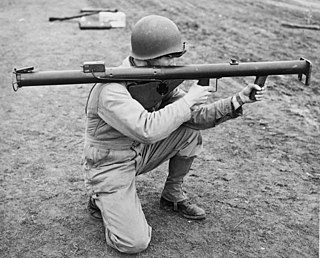
A rocket launcher is a weapon that launches an unguided, rocket-propelled projectile.
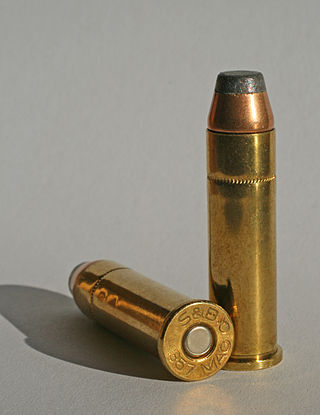
A centerfire cartridge is a firearm metallic cartridge whose primer is located at the center of the base of its casing. Unlike rimfire cartridges, the centerfire primer is typically a separate component seated into a recessed cavity in the case head and is replaceable by reloading.

In an explosive, pyrotechnic device, or military munition, a fuse is the part of the device that initiates function. In common usage, the word fuse is used indiscriminately. However, when being specific, the term fuse describes a simple pyrotechnic initiating device, like the cord on a firecracker whereas the term fuze is used when referring to a more sophisticated ignition device incorporating mechanical and/or electronic components, such as a proximity fuze for an M107 artillery shell, magnetic or acoustic fuze on a sea mine, spring-loaded grenade fuze, pencil detonator, or anti-handling device.

The Minié ball or Minie ball, is a type of hollow-based bullet designed by Claude-Étienne Minié, inventor of the French Minié rifle, for muzzle-loading rifled muskets. It was invented in 1847 and came to prominence in the Crimean War and the American Civil War, where it was found to inflict significantly more serious wounds than earlier round musket balls. Both the American Springfield Model 1861 and the British Pattern 1853 Enfield rifled muskets, the most common weapons used during the American Civil War, used the Minié ball.
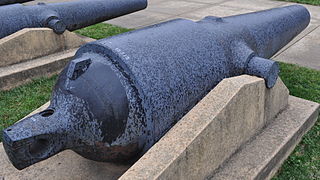
The Brooke rifle was a type of rifled, muzzle-loading naval and coast defense gun designed by John Mercer Brooke, an officer in the Confederate States Navy. They were produced by plants in Richmond, Virginia, and Selma, Alabama, between 1861 and 1865 during the American Civil War. They served afloat on Confederate ships and ashore in coast defense batteries operated by the Confederate States Army.

Field artillery in the American Civil War refers to the artillery weapons, equipment, and practices used by the Artillery branch to support the infantry and cavalry forces in the field. It does not include siege artillery, use of artillery in fixed fortifications, or coastal or naval artillery. Nor does it include smaller, specialized artillery classified as small arms.
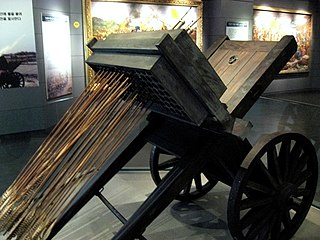
The hwacha or hwach'a was a multiple rocket launcher and an organ gun of similar design which were developed in fifteenth century Korea. The former variant fired one or two hundred rocket-powered arrows while the latter fired several dozen iron-headed arrows or bolts out of gun barrels. The term was used to refer to other war wagons or other cart-based artillery in later periods, such as that developed by Byeon Yijung in the 1590s.

A fougasse is an improvised mortar constructed by making a hollow in the ground or rock and filling it with explosives and projectiles. The fougasse was used by Samuel Zimmermann at Augsburg in the sixteenth century, referred to by Vauban in the seventeenth century, and well known to military engineers by the mid-eighteenth century. This technique was used in several European wars, the American Revolution, and the American Civil War. The term is still used to describe such devices.

Fragmentation is the process by which the casing, shot, or other components of an anti-personnel weapon, bomb, barrel bomb, land mine, IED, artillery, mortar, tank gun, or autocannon shell, rocket, missile, grenade, etc. are dispersed and/or shattered by the detonation of the explosive filler.
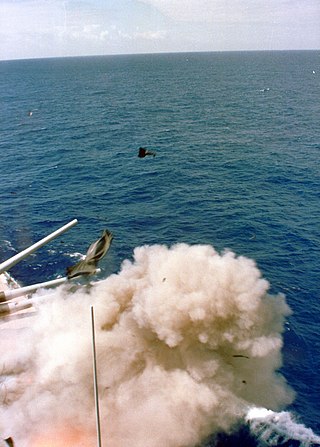
On 19 April 1989, an explosion occurred within the Number Two 16-inch gun turret of the United States Navy battleship USS Iowa (BB-61) during a fleet exercise in the Caribbean Sea near Puerto Rico. The explosion in the center gun room killed 47 of the turret's crewmen and severely damaged the gun turret itself. Two major investigations were undertaken into the cause of the explosion, one by the U.S. Navy and then one by the Government Accountability Office (GAO) and Sandia National Laboratories. The investigations produced conflicting conclusions.
The following are terms related to firearms and ammunition topics.

The Gallager carbine is an American black powder breechloading rifle produced in the American Civil War.
In firearms and artillery, the primer is the chemical and/or device responsible for initiating the propellant combustion that will push the projectiles out of the gun barrel.
Foxfire Mountain is in Sevierville, Tennessee, United States in the foothills of the Great Smoky Mountains National Park. Foxfire Mountain occupies an area known as Pearl Valley near Dunne's Creek. The area known as Foxfire Mountain is a 150-acre parcel of land that is rich in history.

The Sprengpatrone or "explosive cartridge" in English was a rifle grenade that was developed by Germany and used by the Wehrmacht during World War II. The Sprengpatrone was designed to be fired from a Kampfpistole flare gun.















